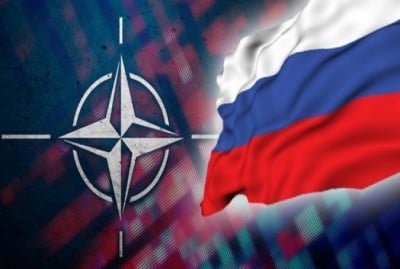NATO Operation in Aegean Sea Heightens Threat of War with Russia

A NATO convoy under German leadership is to begin operations in the Aegean Sea in the next few days, NATO Secretary General Jens Stoltenberg and German Defence Minister Ursula von der Leyen said Thursday.
The official goal of the mission is the complete closure of the Aegean to refugees, militarily strengthening “Fortress Europe” against refugees from the war zones in the Middle East. The dispatch of warships to the strategic Aegean Sea also heightens the risk of NATO intervention in the Syrian civil war and war with Russia.
Stoltenberg said in a press release that the goal of NATO was “the disruption of the routes used by smugglers and for illegal migration in the Aegean.” He boasted that the ships of the Standing NATO Maritime Group 2 (SNMG 2) had already arrived in the mission area 48 hours after the decision of NATO defence ministers was taken two weeks ago. Now it was a matter of collectively finding “solutions” for the “crisis.”
By “solutions” of the refugee crisis, Stoltenberg and NATO mean the military strengthening of the Greek and Turkish coast guard and the European border protection agency Frontex in order to detect and stop refugee boats, also possibly forcing them back.
Stoltenberg said,
“Our ships will provide information for the Greek and Turkish coast guard and other national authorities, allowing them to act even more effectively against illegal trafficking networks. We will also establish direct connections to European Frontex … so that it can do its ‘job’ more effectively.”
In other words, Frontex, supported by NATO warships, should conduct its notorious “push-back” operations more intensively, i.e. a refugee boat being tracked should be “towed back where it came from—for example, to Turkey”. German Interior Minister Thomas de Maizière demanded this last December in an interview with Die Welt. Now it is official EU and NATO policy. Stoltenberg said, “If people are rescued who have come through Turkey, they will be returned to Turkey.”
The operation comes from an initiative by German Chancellor Angela Merkel, agreed at a meeting of NATO defence ministers on 11 February. Berlin is taking over the management of the NATO alliance. In a statement last Thursday, von der Leyen praised the NATO decision “under German leadership” as being “quick and clear”. Last Friday, the German supply ship Bonn, which will lead the naval group, set off from the NATO base at Souda in Crete. On board was the German Commodore Jörg Klein, commander of SNMG 2.
With the military mission, the German government wants to “drastically and sustainably” reduce the number of refugees coming to Greece via Turkey, as de Maizière declared on the periphery of an EU meeting in Brussels. This should happen by March 7. Then a special EU summit would take place attended by Turkey.
The official goal of the Merkel government is to commit the Erdogan regime to a dirty deal on fully closing the borders for refugees and to detain refugee boats before they can even leave Turkey. As “compensation”, the German government will provide financial support to Ankara. Last week in a government statement, Merkel reaffirmed her support for a no-fly zone in Syria, a central demand of the Erdogan government and an important condition for Ankara’s military invasion of Syria.
The NATO mission in the Aegean not only entails increased support for Turkey’s war drive against the Kurds and the Syrian government, but is a direct part of the NATO war preparations against Russia.
An official NATO report indicates that the SNMG 2 force had conducted “intensive operations with the Turkish Navy” in early February. This included carrying out air defence operations, submarine war operations and live firing exercises (GUNEX). Turkish F-16 fighter jets were also involved in the exercise.
According to Klein, the aim was to develop the force’s “own abilities” and “to consolidate a team” out of the units. As well as the German flagship, the “team” that he is currently leading in the Aegean includes two heavily armed frigates, the Canadian vessel HMCS Fredericton and the Greek ship Salamis (F-455), and a Turkish warship. The SNMG 2 group is part of the NATO Response Force (NRF), the NATO rapid reaction force, which was systematically upgraded last year against Russia.
The location and organisation of the exercise alone underscore what NATO is preparing. Russia is currently the only power that is active in the region with larger naval units and warplanes, and is considered as an enemy by NATO. The Russian Air Force is supporting Syria’s Assad regime being combatted by the West, and warships of the Russian Black Sea Fleet regularly transit the Aegean between their home ports in the Crimea and Tartus in Syria, where the only Russian naval base is located in the Mediterranean Sea.
The increasing NATO presence in the Aegean heightens the risk of a direct clash between NATO and Russia. According to the Russian Defence Ministry, there was a near-collision off the Greek island of Lemnos in December, between a Turkish fishing boat and the Russian destroyer Smetliwij. Russia regarded the incident as a deliberate provocation by the Turkish Navy, and summoned the Turkish military attaché in Moscow. Since the shooting down of a Russian fighter jet by Turkey on November 24, 2015, tensions between Turkey and Russia have steadily increased.
In its latest edition, news weekly Der Spiegel describes the consequences, including those unintended, of the NATO mission. It says of the growing “risk of war between Russia and Turkey”:
“It is the year in which the world stands as close to a nuclear war as never before in the history of the Cold War. Provocations, red lines, which are crossed, airspace violations, a shot-down aircraft. A missile fired in error or a submarine commander who loses his nerve can trigger a world war.”

